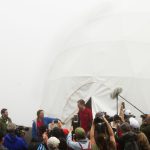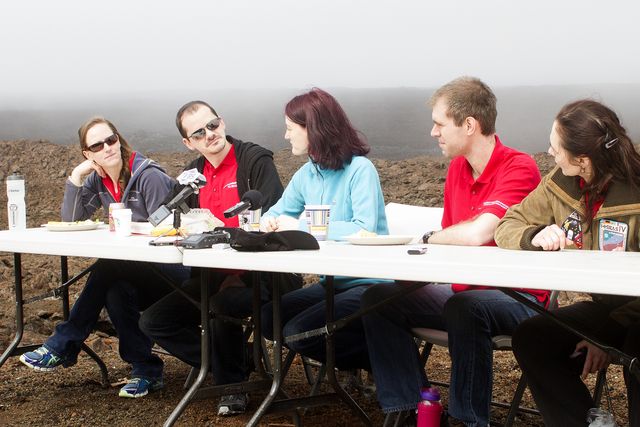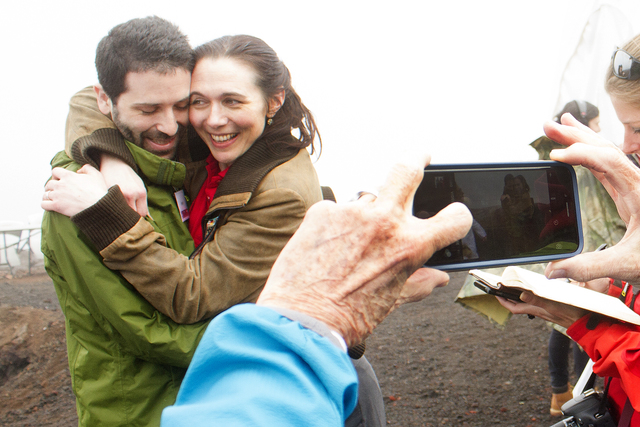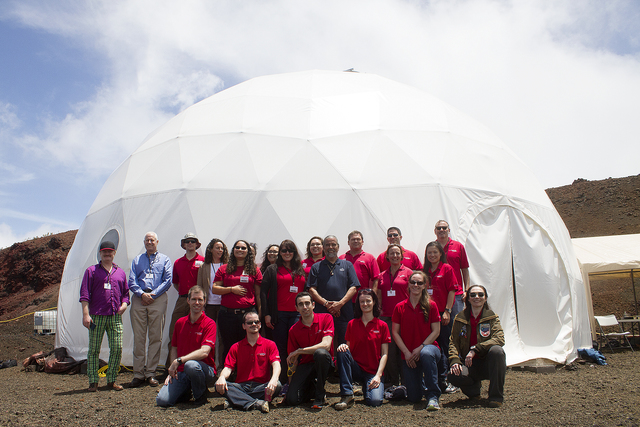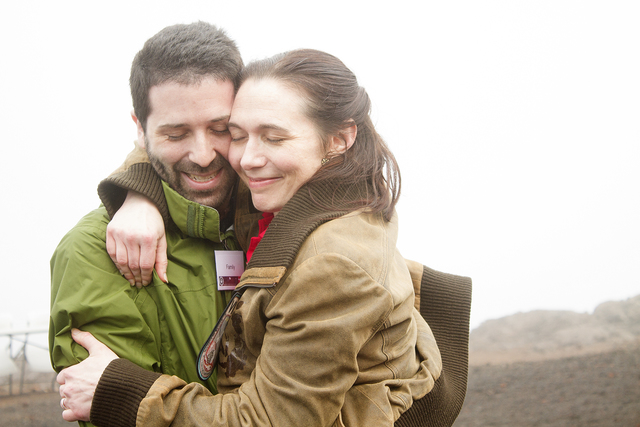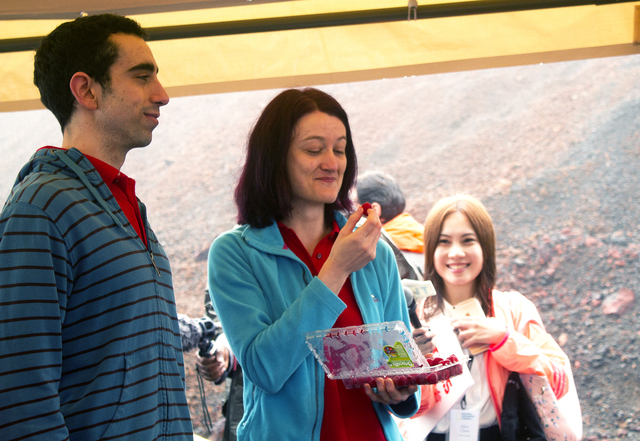Aphysician, a physicist, and an architect walk into a dome, along with an aerospace engineer, an astrobiologist and a soil scientist.
It’s not the start of a terrible joke but instead the premise of the fourth Hawai‘i Space Exploration Analog and Simulation mission, which came to a close Sunday.
A NASA-funded study, HI-SEAS aims to mimic living conditions on Mars, from the location — 8,200 feet up the slopes of Mauna Loa, on a reddish volcanic surface that looks and feels extraterrestrial — to protocol — crew members cannot leave the habitat dome without a spacesuit.
The fourth mission lasted 365 days and is the longest American Mars simulation to date. HI-SEAS is run by the University of Hawaii.
“I’m excited,” UH principal investigator Kim Binsted said Sunday morning before the front door of the dome was unzipped and the crew was welcomed by family, fellow researchers, and media outlets from as far away as Taiwan and France (two crew members are from Europe). “I’m excited to welcome them back.”
Trays of fresh fruit including pineapple, cantaloupe, watermelon and bananas were laid out as the crew’s first real breakfast in a year. Only shelf-stable foods or freeze-dried items are allowed in the habitat, which consists of 1,200 square feet of floor space, a second-floor loft that has six small bedrooms, and an attached workshop.
The dome runs on solar power with hydrogen cells as backup fuel.
“Little by little, we’re trying to make it more real,” said Henk Rogers, chairman of Pacific International Space Center for Exploration Systems, which owns the dome and leases it to NASA and the universities. “In the future, we plan for them to make their own hydrogen.”
A year is a long time to spend in the same 1,200-foot space with the same group of people, and that’s exactly the point. Before sending any astronauts on missions to Mars, where resources are virtually nonexistent, NASA researchers need to know how to build the right team. They need to know how that team handles itself in the stress of isolation.
“It’s important that we protect the astronauts’ health, the astronauts’ safety, but we also need to protect their mental health,” said chief engineering officer Andrzej Stewart. “If you’ve got a crew that’s happy, that’s healthy, you’ve got a crew that can operate.”
Researchers from universities around the country conducted studies on team cohesion even as the crew itself was working on individual projects.
Crew commander Carmel Johnston worked on plant cultivation.
“I want to find a sustainable way for people to grow in space,” she said. “I think the things we were able to figure out here will help us get into that mindset.” Kale, chard, radishes and tomatoes thrived in the habitat. Red peppers did not.
For the crew, maintaining a work-life balance was difficult, considering they lived at their own job site.
“The biggest thing is finding enough time for yourself, and not thinking ‘I need to do this, that, or the other thing,” Johnston said. “There’s always something to do. It’s hard for six overachievers to do that (step away).”
Though crew members like Johnston and Stewart had long wanted to participate in a space simulation mission, others, like crew architect Tristan Bassingthwaighte, applied on a whim. Bassingthwaighte was studying in Shanghai, in the middle of graduate research on space architecture.
He sent off the application after corresponding with HI-SEAS III crew member Jocelyn Dunn.
“I’m not a scientist at all,” he said. “I thought maybe I’d get some information (for my research) during the interview process … I went from not knowing about HI-SEAS to being in the dome in about three and a half months.”
Bassingthwaighte’s research involves designing for people who are going to be in “far rougher” places than Mauna Loa, and having firsthand experience with what works and what doesn’t work was enlightening.
“A big one would just be privacy in general,” he said. There is no soundproofing in the dome, for example.
“Andrzej will play his Green Day music when he’s cooking on Sundays, and you hear it no matter where you are,” Bassingthwaighte said.
During down time, crew members read, knitted, watched movies, played Minecraft, and salsa danced. They explored nearby lava tubes from the safety of their space suits, and exchanged presents on holidays and birthdays.
At Thanksgiving, virtual reality — a first for HI-SEAS, and an initiative of NASA research partner Smart Information Flow Technologies — allowed them to “sit” at a table with their families and listen to what everyone was thankful for.
“It’s certainly very rewarding,” said SIFT senior researcher Peggy Wu.
Chief medical officer and crew journalist Sheyna Gifford said she had been impressed by the group’s overall dynamic when it came to solving problems.
“As individuals, we’d get stuck,” she said. “As a group, we could work through it. I don’t think there’s a problem we weren’t able to work through (together).”
That was particularly true two weeks ago, when the plumbing system failed and the crew had to figure out how to repair it.
And the crew went in knowing they could expect some conflicts.
“One of the challenges was to talk among the group, and meet the conflicts head on, and make sure they don’t escalate,” said chief scientific officer and crew physicist Christiane Heinicke, who is also a cello-playing engineer.
Isolation presented other challenges, particularly regarding separation from family and friends. Although the crew could correspond with people in the outside world, they did so on a 20-minute delay to better mimic Martian conditions. Gifford’s grandmother passed away. Crew biologist Cyprien Verseux, a native of France, had to learn about last November’s terrorist attack in Paris from inside the bubble.
Still, during a morning news conference all members said they’d do the simulation again.
“There’s just the focus of the mission, wanting to achieve something greater than yourself,” Stewart said.
The crew was able to pass that sentiment on throughout the year, through a HI-SEAS blog that let the world know about their work.
“I did not anticipate that people would be so supportive,” Gifford said. “I did not see that coming … all people, everywhere, people just come together.”
“When it comes to space, I think we’re at our best,” she said. “We drop our pettiness, we assume a global outlook, we are bold, we are brilliant, we are unstoppable.”
There are two more HI-SEAS missions planned, both set to last eight months. An application form is available at http://hi-seas.org/?p=5695 and must be received by September 5.
Email Ivy Ashe at iashe@hawaiitribune-herald.com.


